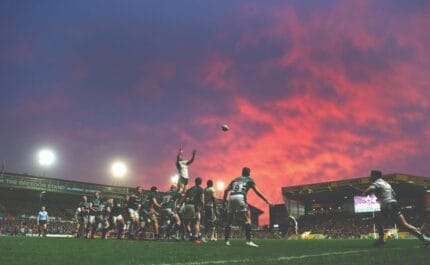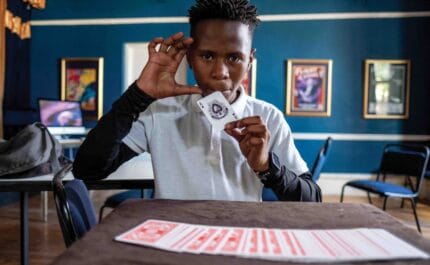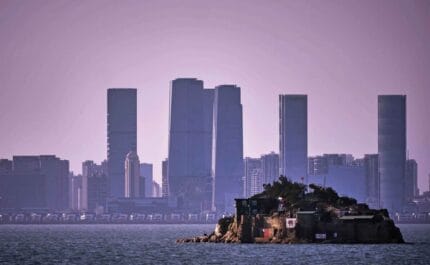The return of the Golden Indian
In 2017 one of Paraguay’s all-time boxing greats re-entered the ring. For DG#28, Laurence Blair chronicled his extraordinary career — and his battle for redemption
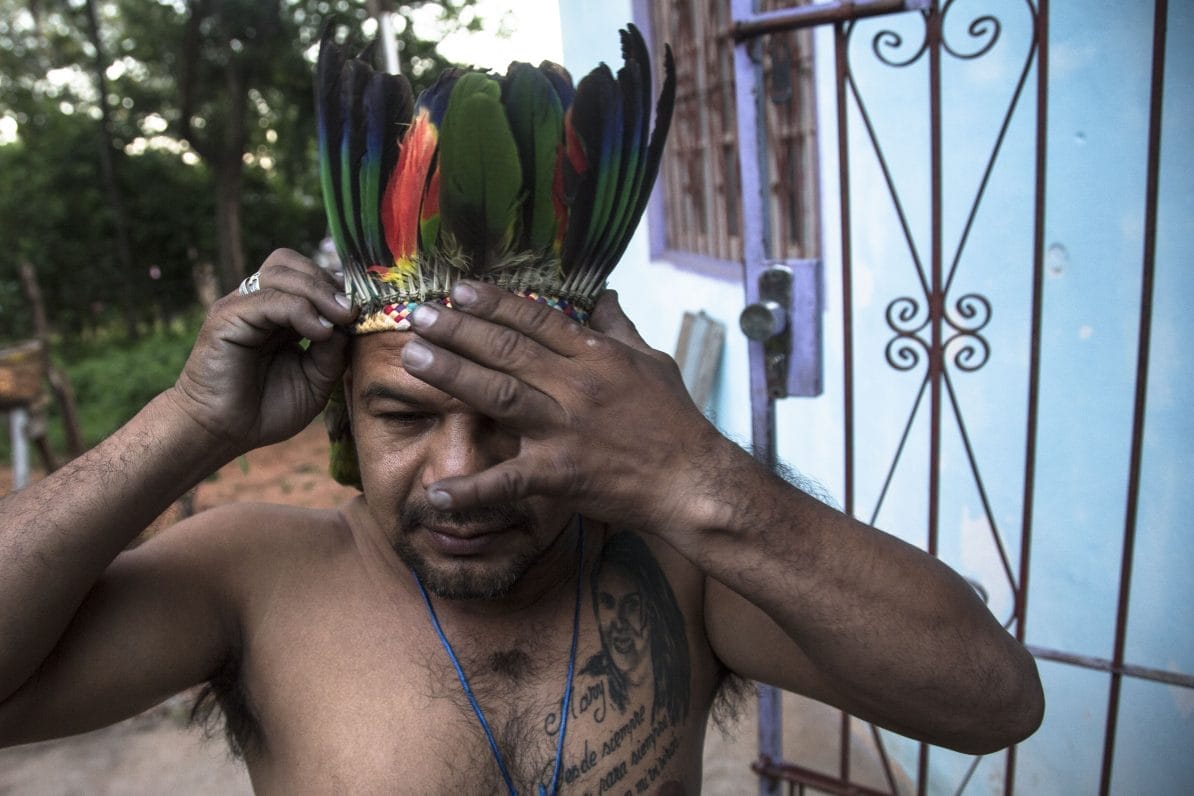
Darío Azuaga pictured outside his home in Ñemby, Asunción, Paraguay, in May 2017
30th September 2017 (Taken from: #28)
Take the road from the centre of Asunción and you’ll follow the bend of the river as it curves out towards the outskirts of Paraguay’s capital. Drive past the crumbling belle-époque palaces of the old aristocracy and the ersatz-Bauhaus compounds of the newly rich. Skirt the canopy of blue canvas that rings the Mercado Cuatro and head past the bus terminal, where indigenous Ayoreo women sell woven bracelets and wood carvings. As you reach the barrio of Ñemby you’ll notice how the lines of cement and breezeblock bungalows begin to thin out. Here, between a tyre-fitting shop and an ice-cream parlour, Darío Azuaga plies his trade as a locksmith. The walls of his workshop are sparsely decorated with pictures of Muhammad Ali, Joe Frazier and “Sugar” Ray Leonard. There’s also a poster of scrappy Filipino Geronimo “Gerry” Peñalosa facing down a Paraguayan boxer known as El Indio de Oro – the Golden Indian.
“I sometimes tell people El Indio de Oro is my brother,” says Darío, as he files a key in a clamp. Most of the pilgrims, who come from far and wide, don’t believe him: they know the Golden Indian when they see him. “They ask, why am I working? But there’s nothing else for it. I’ve got to work.”
Famed for a relentless right hook and pacey footwork that belies his stocky frame, Darío, now 43, is one of Paraguay’s all-time greatest boxers. Admittedly, the competition isn’t huge in this California-sized country of barely seven million people, a stranger to both the backpacker circuit and international headlines. But Dario is also the holder of multiple titles as champion of South America, Latin America and the Hispanic world, and was in his glory days – according to the World Boxing Organisation – the best in his weight division on the planet.
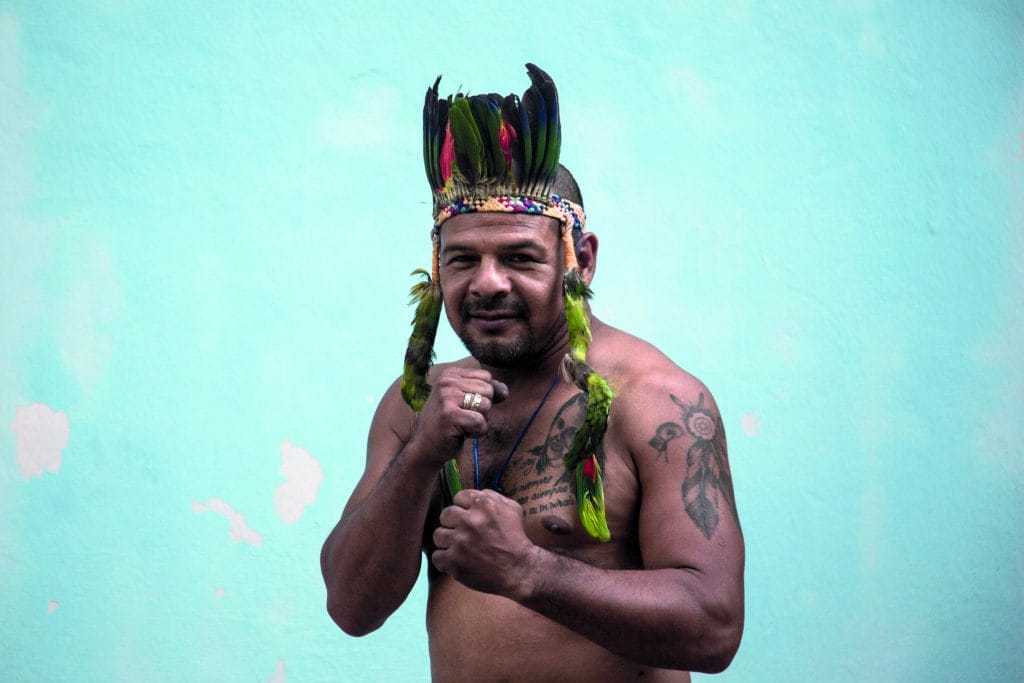
Boxer Dario Azuaga, aka the Golden Indian
In a 23-year career, he won 89 bouts out of 116, including an impressive 72 knockouts, 15 of which were in the first round. “I’ve fought in all the continents,” Darío reflects, slurring his words slightly. “In South Africa, in Australia, in Canada, in Europe – and the furthest away was the Philippines, which was 32 hours of flying. The other side of the earth.”
Darío came close to winning a world title, wealth and fame. But injury, mismanagement and prejudice robbed him of the chance to fight for greatness. Gradually his form deteriorated and the defeats began to pile up. He hung up the feathered headdress he wore during his entrances, alongside the belt he won as champion of the Hispanic world. Then, disappointment was joined by a numbing, all-consuming grief.
Every morning, Darío genuflects before two framed pictures. One is San Cayetano, the patron saint of workers and gamblers. The other is of a smiling teenage girl, in a glittery pink quinceañera dress in one image, sporting a pair of white boxing gloves in another.
The ritual is a hint to the powerful faith now driving Darío. For the affable locksmith is not out for the count just yet. He has taken up his gloves once more and aims to finally fight for that elusive world title. If he wins, it will be one of the more remarkable comeback stories in modern boxing. And it will be cheered across Paraguay as another sign that this underdog nation – long victim to corruption, dictatorship and bullying by its neighbours – is able to stand up for itself once more.
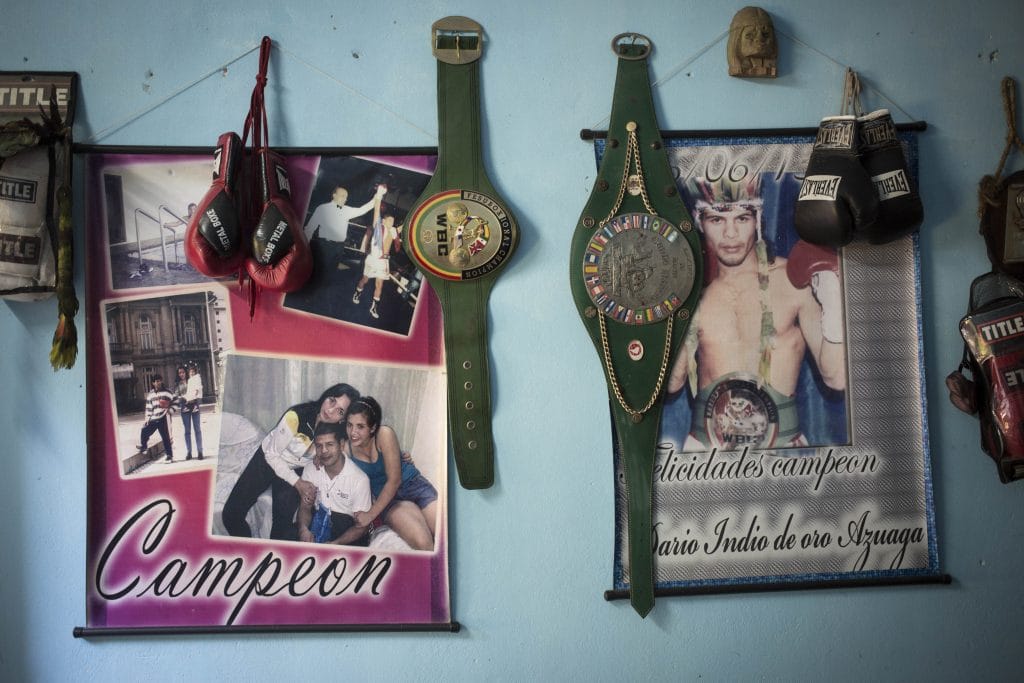
Dario’s gloves, belts and trophies from his 23 year boxing career
Darío came close to winning a world title, wealth and fame. But injury, mismanagement and prejudice robbed him of the chance to fight for greatness”
Darío’s story started in Ciudad del Este, the city founded six decades ago next to the Paraná River, on the triple border where Brazil, Argentina and Paraguay meet. It was originally named after Alfredo Stroessner, Paraguay’s brutal US-backed dictator, and Puerto Presidente Stroessner fast became a mecca for smuggling. Everyone from fishermen to top-ranking generals ferried fake designer clothing, Scotch whisky, cheap electronics, cocaine and marijuana across to Brazil’s metropolises. “Contraband,” Stroessner famously said, “is the price of peace.”
By the early 1970s, what was once a patch of jungle had been smothered by towering shopping malls manned by Lebanese, Indian, Korean and Taiwanese traders. Weave your way around the pedestrians hauling bags of booty across the Bridge of Friendship to Brazil, and the brash signs give a flavour of the city’s international character: Bonita Kim, Brands for Less, Shopping Mína India. Walk down the steep slope to the river and you’ll find rough neighbourhoods of poor Paraguayans – drawn from the rural interior by the promise of a slice of the action – springing up on both sides.
Darío Azuaga threw his first punches in one such neighbourhood, the Barrio San Rafael. His father, Pastor Azuaga, was an amateur boxing legend, a traditional stylist who was admired for his chivalrous conduct and who went by the name El Indio Guaraní. His moniker was a nod to the main indigenous people who historically inhabited eastern Paraguay, the Guaraní, whose language is still spoken by most of Paraguay’s population. Local commentators insist that international boxing authorities reinstated the minimosca division – light flyweight, or under 49kg – in the late 1960s with Pastor specifically in mind. But a quarrel between Pastor and the national boxing grandees led them to send an inferior fighter to the world championships. “They left me in the field of forgetting and the world of nothing,” Pastor was fond of lamenting. He retired in the late ’70s, opening a boxing gym in Puerto Stroessner, and bringing his family, including two-year-old Darío, with him from the rural province of Concepción.
Pastor wanted his son to be a priest, or, failing that, a journalist. But he couldn’t resist coaching his enthusiastic protégé. The city around them also encouraged Darío to scrap from early on. Aged eight or nine, he was among the shoeshine boys who slugged it out in underground street-fighting championships. Local taxi drivers organised the fights and bet money on the results. “That was when the Rocky films were coming out… we went to the cinema and we all came out as boxers,” Darío says with a laugh.
But Darío made a habit of only taking on those bigger than him, the neighbourhood bullies and show-offs. One day, aged 13 or 14, at a local club, he stumbled backwards, smearing mud on an older boy’s white leather shoes. Darío apologised, but was smacked around the head for his trouble. “You think because your dad’s a boxer you can do what you like?” said the boy. His pride injured, Darío responded in kind with two hard blows. “Have you seen how a tree falls? That’s how he fell.” Darío spent a week sweeping up the local police station as a punishment. Worse still, they shaved off his trademark mullet.
By the time Darío finished his national service in Asunción – parade-ground drills in 80 percent humidity, boredom in the barracks – the Cold War was over. Stroessner’s pet city was rebranded as Ciudad del Este, the general went into exile, and under the grudging tutelage of one of his most corrupt lieutenants Paraguay made a shaky transition towards democracy. “I didn’t have any other options, I didn’t know how to do anything else. So what am I going to do?” asks Darío. “Box. So I got involved in boxing. And it turns out I was pretty good.”
Have you ever heard of a son of a millionaire becoming a boxer? Well. All the best boxers come from the deepest poverty there is”
Darío wears his laurels lightly: “I think I have 15 or 20 knockouts in a row,” he says (the real figure is 28). “I don’t hold all the details in my head, because I’ve been hit more times than I’ve had fights.” He pulls down the shutter on the shop and jumps on his motorbike. We coast the 300 metres downhill, along cobbled backroads fringed with pink lapacho and jacaranda trees, to the bungalow he shares with Angela, his wife of over 20 years. It’s Holy Week, and Angela has baked a fresh batch of traditional chipa. As we chew on the starchy bread, Darío puts on DVDs of his fights. The quality is grainy, but you can still see why he was once classed among the best pugilists to come out of the southern hemisphere.
Take his 1997 bout against Brazil’s João Cardoso in Buenos Aires, Darío defending the South American bantamweight title. Darío tracks Cardoso, nearly a foot taller, around the ring – ducking, weaving and testing the Brazilian’s defences with the occasional jab. Twice Darío lets himself be pushed onto the ropes, absorbing the attack on his gloves. And then he breaks out with an explosive right hook, pressing his advantage with a flurry of blows. In the sixth round, Cardoso totters and slumps to the floor twice, almost unprompted, before the referee declares a technical knockout.
Then there’s the bout barely a month later on home turf in Asunción, taking on Emiliano Ferrer of Colombia for the World Boxing Council Hispanic world title. Ferrer’s waist comes up to Darío’s chest. Darío crouches under the blows, getting in close to deliver his own. And then, in the second round, he spies an opening, and leaps upwards with an upper hook that unbalances the Colombian. Darío seizes his chance with a punishing onslaught of strikes. The home crowd screams. A round later, the same trick – feint, duck and hammer-blow – lays Ferrer out. Knockout.
Consult Darío’s scoresheet and you’ll see a streak of green from 1993 to 1999 where he faced down an incredible 48 opponents in a row, month after month, without a single defeat. Small wonder, then, that Pastor’s humble nickname alchemised, with Darío soon crowned El Indio de Oro. Here, out of nowhere, was a Paraguayan champion who defeated all comers, his every appearance turning into gold for the boxing impresarios who ran his fights. A magazine cover from that time shows Darío in mid-somersault post-victory, suspended above the ring, as if flying.
Everyone around him was making money, except the Indio de Oro. “Boxing all around the world is a sport by the poor for the rich,” he says, swatting at the mosquitoes that enter the house at dusk. “Have you ever heard of a son of a millionaire becoming a boxer? Well. All the best boxers come from the deepest poverty there is,” he adds, citing an acquaintance, Manny Pacquiao, as an example. “It’s one thing to have fought so many fights and travelled so much but they don’t give you that one fight that could win you real money.” Darío saw off several would-be regional champions but had to wait until he was 25 before getting a qualifier fight for the world title.
“Why? Because they don’t want to let Paraguay come to Argentina or the United States and make history in a sport that they control. That’s the big mafia of sport, simple.” His condition gradually deteriorated. He went into the crucial fight, number 49, visibly suffering from a recently dislocated shoulder, the famous right hook a fraction of its normal power, and lost to a mediocre opponent. As Darío’s coach tells me, his then-manager demanded too much money from promoters for another shot and – as with Pastor – they passed him over in favour of younger boxers.
Darío began to get some international matches but by now he was past his prime. Those he faced had more money and expertise behind them, and the fights tended to be in heavier weight divisions than he was used to. He opened the locksmith shop to make ends meet; his fitness suffered. “I couldn’t wait for the weekend to come – music, beer, barbecues, all of that… I didn’t value life, I didn’t give a fuck.” Still, he took some solace in coaching the next generation. Life was okay. Until Darío was floored by the biggest blow to date.
I think I have 15 or 20 knockouts in a row. I don’t hold all the details in my head, because I’ve been hit more times than I’ve had fights”
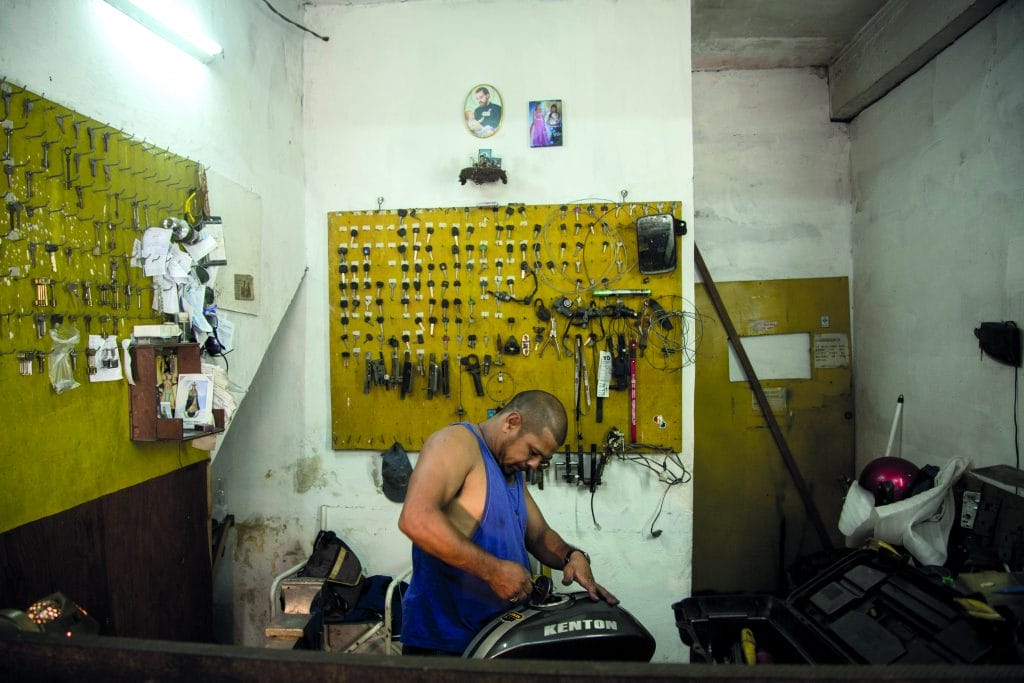
The Azuaga locksmith shop in the Ñemby district of Gran Asunción: above Dario’s head are framed portraits of San Cayetano and María del Mar
One autumn night in Asunción, a thunderstorm was coming in off the river, lighting up the sky with sheets of purple as the rainwater ran in torrents past the shuttered stalls of the Mercado Cuatro.
I splashed back and forth across the street, looking for a boxing gym hidden above an Indian fabric shop. Upstairs, lithe young men and women were sparring in the combative stances of mixed martial arts (MMA) and Muay Thai kickboxing. I had come to find out about María del Mar.
Andres Ayala – a slight, weathered man in his sixties with kindly eyes – took me into his office. “María del Mar,” he said with a sigh, perching on the bare desk before telling me her story. “I’m a Paraguayan but I grew up in Buenos Aires. I’ve seen a lot of boxers and, modesty aside, it was me who introduced women’s boxing into Paraguay about 17 years ago.”
In an extremely Catholic and conservative culture, most either laughed at or railed against the idea of women in boxing gloves. But Andres persevered, and there was one girl in particular who promised greatness. “She had technique, it was impressive how she moved in the ring, it was marvellous to watch.”
María’s potential was, perhaps, unsurprising. Boxing ran in her blood. “She had the same upper cut as her dad, she had the same footwork, the same dodge… the first thing she saw in her house were boxing gloves,” Andres explained. Her grandfather, Pastor, taught her the basics, and she insisted on taking up the family profession, over Darío’s protests. She was dubbed La Indiecita, the Little Indian. In 2009, one of the big names in local women’s boxing was Pamela Vill, who came to the sport via modelling and stripping in Asunción clubs. “I’m the sexiest Boxer in the world, and what!!” her Twitter profile reads today. María told Darío: “Dad, I can beat her.” A few months later, the Little Indian stepped into the ring with the sometime glamour model and won the bout in 90 seconds.
Making a living from boxing wasn’t easy for María: there was no government support for women boxers, she had university fees to pay and she wanted to help look after her family. But Andres, Darío’s coach through his glory years and a close friend of the family, encouraged her to persist. “I said that if she put in the effort, she could be South American champion, and soon. And from there have a break, and then go for the world title,” he recalls. “She was going to be world champion.” It seemed like the third generation of Azuaga contenders would finally make the big time. But those dreams were cut short.
It was late 2014, two days after Christmas, and the family was getting ready to spend the New Year with Angela’s parents in the country. Darío was finishing up a training session downtown. At Crichi’s Gym, it was tradition to have a barbecue and a few beers to round off the year. But soon after taking off his gloves, he got a telephone call from Angela. María had been found, lifeless, in the bathroom at home. “I said to the boys to get me there as quick as possible.” One of them raced Darío up the highway to Ñemby in his pickup. They’d already taken María down and put her on her bed.
“I tried to resuscitate her, I did mouth-to-mouth, I checked her pulse, I tried to give her air,” Darío murmurs. For a moment María seemed to exhale: her parents dared to hope she might still be alive. The emergency services had yet to arrive, so they flagged down a patrol car in the street and rushed her to the hospital. “She was in there for half an hour with the doctors,” recalls Darío. “And one came out and said, ‘There was nothing we could do.’ That’s what I remember. Because afterwards it felt like I was dreaming. There are things I don’t want to remember.” María was 19.
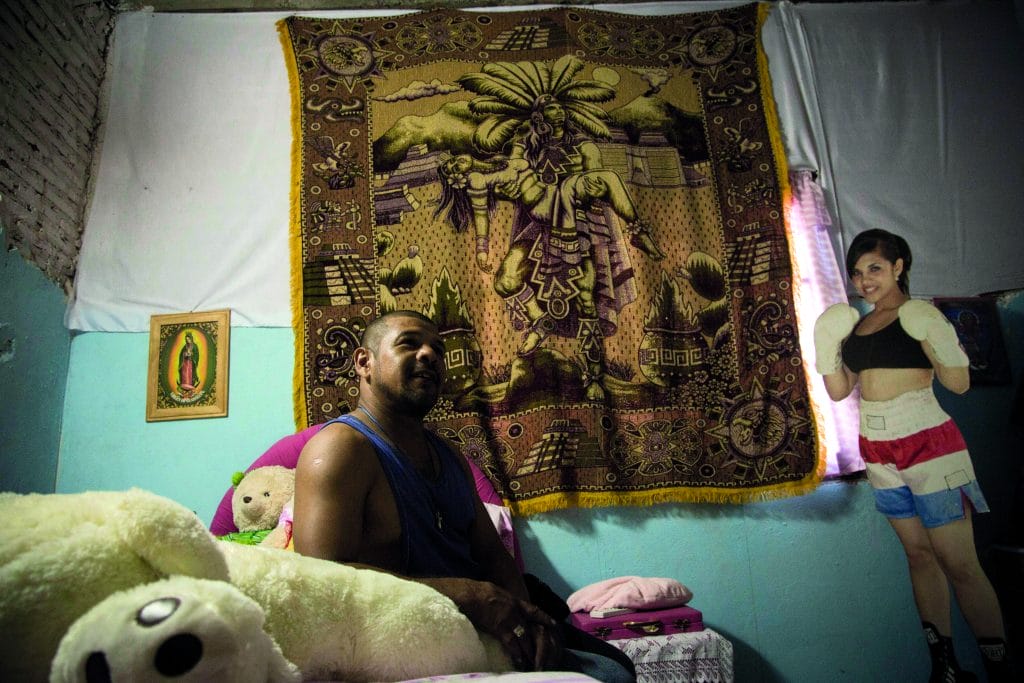
Dario with a life-size cutout of his daughter, María del Mar, who boxed under the name ‘La Indiecita’, ‘the Little Indian’
It looked as though María had taken her own life. But those who knew her best don’t even consider this as a possibility. She hadn’t shown any signs of unhappiness; she had won a bout against an Argentinian opponent just a month before.
There are rumours of a wealthy, possessive boyfriend, an argument while they were at home alone, an attempt to pass her killing off as a suicide, a bribe to the police. It wouldn’t be surprising in Paraguay, still one of the most corrupt societies in the world, where – as Darío puts it – justice is for hire.
A private investigator employed by the family disputes the police’s version of events. Darío says that the state is keeping back key evidence, including his daughter’s mobile phone, to avoid an official inquest.
We move to the teenager’s room. Darío sits on the pink bedspread next to a huge stuffed animal, while Angela stands by a life-size cut-out of her daughter. “This is our sanctuary. Sometimes I go a bit mad and I come and talk to the photo,” Darío admits. “If she were here, it would all be a mess, music, laughter, joy… The room is just how she left it. We’re stopped completely in time. Sometimes at the weekend I go out, I have a few drinks, and I always, always wake up in my daughter’s bed. Always. I have to wake up here. And I don’t know,” he adds, raising his voice as it breaks. “It’s like we’re mute.” Angela occasionally takes all of María’s clothes from the cupboards, washes them, and puts them back.
Small rituals keep María’s memory alive. When she passed her dad in the hall, she’d aim a few quick jabs at his stomach – “You’re getting slow, old man!” – and would tussle with her mum in the kitchen. Her parents sometimes recreate these play-fights; they repeat María’s favourite jokes. But more than this, faith has helped Darío and Angela survive. “There’s no psychologist that can help you in this,” says Darío. “Medicine can’t do anything against these kinds of powerful feelings… Only God, and religion, and belief, can help.” The couple are now regular church-goers. “Things happen for a reason,” the boxer says. “There is a plan. And now we’re fighting day by day – not trying to get over things, because you can’t get over this. The thing is, you get used to carrying this pain, this cross. It’s very heavy. But believing in God makes the cross lighter.” Darío and Angela believe, unshakeably, that María is still with them: and that she is willing her dad on, to one final shot at glory.
Before his daughter died, Andres says, Darío “was just on the point of retiring, saying that he’d already done it all. And suddenly one day he calls me and says, ‘Coach, I want to go back… It feels like my daughter is giving me strength from heaven… I want to be world champion for her.’” Andres didn’t need persuading. “Darío, you’ve always got me. I’m at your side,” he replied.
Dario upped his training regime, cut back on drinking and stopped smoking, something María had always begged him to do. “She gave me strength to quit,” he says. “I’m fighting more for her now… She always wanted to see her dad become a champion. This is like therapy for me, because I know that she’ll be happy if I’m boxing.” Darío now wears a tattoo of his daughter above his heart.
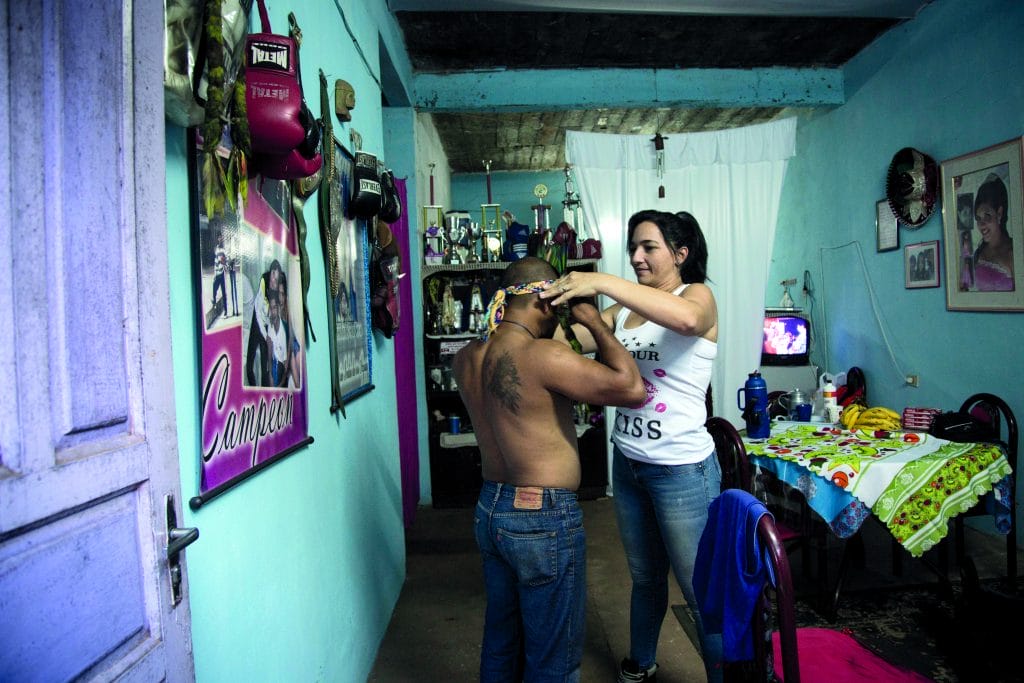
Darío Azuaga at home with his wife Angela
In September 2016, Dario returned to his hometown to fight for the South American title of the World Pugilism Commission (WPC), a relative upstart in the fragmented organisational structure of international boxing. The bout was held in the Plaza Jesuítica, a new open-air shopping complex modelled on the ruined Jesuit missions nearby, which once corralled the Guaraní Indians into utopian communities.
For the first few rounds, the Indio de Oro struggled to summon the old fighting spirit. He was slow on his feet, taking hits, clinching with his burly opponent, an Argentine southpaw. At the edge of the ring, Andres fidgeted nervously with a towel. The crowd grew restless. But by the fourth round, the old form was back. Darío dodged a welter of punches, before – as with that teenage bully three decades ago – deploying the right hook once, twice. The stifling night air came alive with shouts; his rival cowered behind his gloves. Two rounds later, it was over.
A few months later, I walked the few blocks from Ciudad del Este’s main strip, down a precipitous slope, into the Barrio San Rafael. It was after dark, and it was easy to imagine the splash of smugglers pushing their boats off across the river. I asked around for Darío’s childhood home, a wooden lean-to halfway down the hill. Its former site is now covered by a concrete basketball court: drug addicts and furtive couples perched in the darkness opposite. Ismael Rodríguez, a plumber, appeared out of the gloom. “Everyone remembers Darío around here. Him and his dad, Pastor. We’re watching him, because Darío is part of our history. El Indio de Oro…” He grinned. “We’re proud of him.”
Across the street in her grocery, Alva Duré remembered a boisterous, wise-cracking kid. “The street fights were clean back then. Things are more complicated now,” she said. She recalled the neighbourhood lore of how a six-year-old Darío careered down the hillside and came off his bike, the wheel crushing his big toe – which later had to be amputated. Others remembered how he returned to the neighbourhood a few years back, spending hours surrounded by his old friends. All were certain that he can win the world title that has long eluded him. “They often say that the poorest people become the biggest stars,” said Augusto Martínez, another old friend. Darío’s friends would, they assured me, tune in to watch his battle for the WPC world title. As the final step before that, though, he had to fight to defend his recently won WPC South American belt.
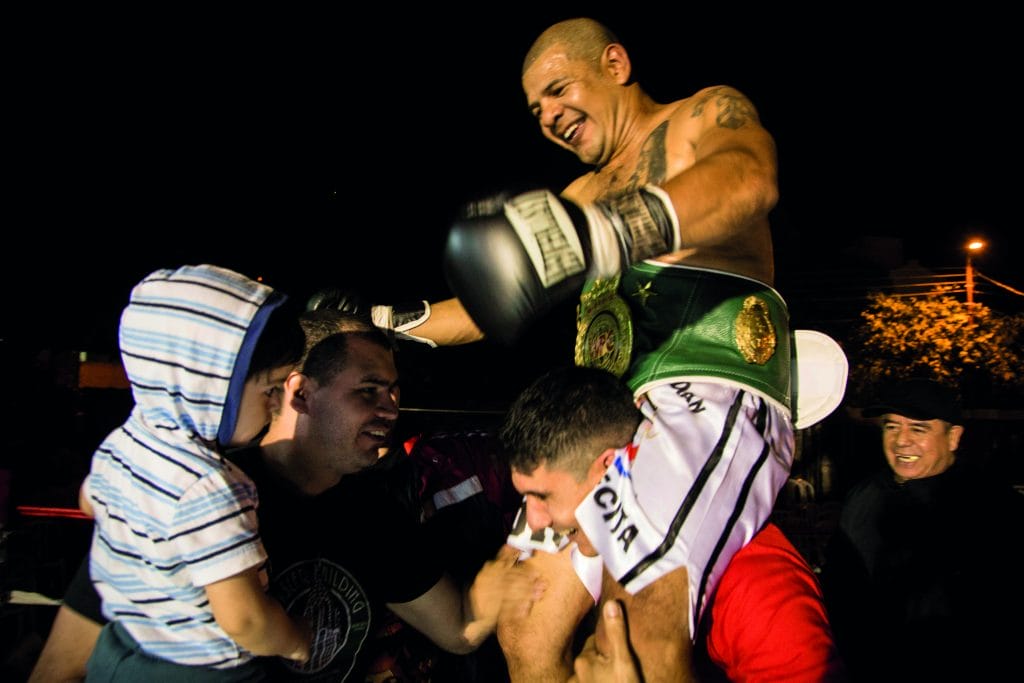
Azuaga celebrates a victory wearing his WPC South American featherweight belt
On 30th September 2017 in Asunción, in the down market neighbourhood of Loma Pytá, a few dozen spectators sprawled on plastic chairs in the dirt-floor courtyard of the local Colorado Party headquarters. Pickups and jeeps were parked a few feet away from the ring, which was illuminated by blinding floodlights. It was a far cry from Darío’s former bouts in Tijuana, Paris and Montreal. The parents of Darío’s Argentinian opponent, Orlando Javier “Panther” Maciel, handled the tickets on the gate, 10,000 guaranies (around £1.30) for the evening’s bouts: several rounds of kickboxing and MMA were scheduled before the title fight.
The Indio de Oro waited inside, in a classroom, with Angela and Andres. A fan knocked at the door and came in to take a selfie with the Indio, bare-chested, sitting in the corner in his jeans and flip-flops. The mood was relaxed but the fight would be far from a pushover: Maciel is ten years younger, and far taller, with a longer reach. After the booming announcer’s voice signalled the end of the fifth fight, Darío got changed. Angela looked patiently, affectionately, on. They have performed this ritual dozens of times before in changing rooms, toilets, working-men’s clubs and casinos all over the world. Darío paced the grimy, chequered floor and shadow-boxed his reflection in the window. Before he left the building to face the crowd, the final touch: Andres slipped a black T-shirt over his head, bearing María’s image and the words: Mi Angel Guardian Indiecita.
The fight started hours behind schedule. Many of the chairs were now empty, but the home crowd was vocal enough. Two TV cameras tracked the contenders around the ring. Maciel came in swinging as soon as the bell sounded, hitting hard and close. But Darío employed his tried-and-tested defensive strategy. He was fast, ducking the punches like a fighter 20 years younger. In the first two rounds, the Panther all but failed to connect with El Indio’s head.
In the third, Darío began a sparing counter-attack. A right cross connected with Maciel’s jaw and sent him to the floor. In the fourth, the Panther fell, got up, then fell again. The referee declared a technical knockout. Angela was the first in the ring to embrace her husband. Andres followed, and strapped the thick, bottle-green South American title belt around Darío’s waist. The Indio de Oro, grinning, was hoisted onto a friend’s shoulders, his torso gleaming in the glare of the floodlights.
A week later, Darío was back at the gym downtown after another day at his workshop. The elusive battle for the world title will follow in early 2018, then maybe a few more fights to finally earn some real money from the craft he’s honed for some 35 years. But whatever happens, he feels vindicated. “I’m already one of the best,” he said, considering María’s portrait on the T-shirt in his hands. “I’ve entered history. My father, me and my daughter. I think forgetting us will be difficult.”
Slow Journalism in your inbox, plus infographics, offers and more: sign up for the free DG newsletter. Sign me up
Thanks for signing up.
